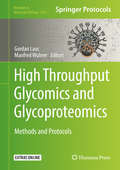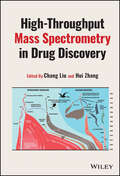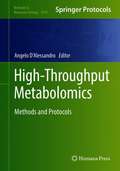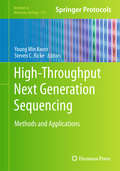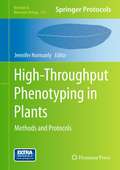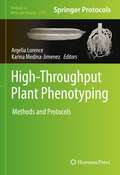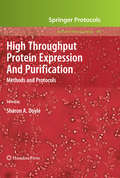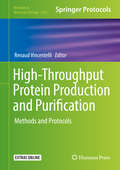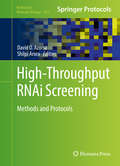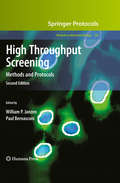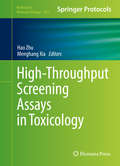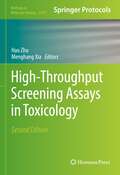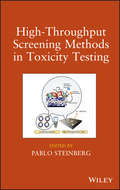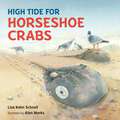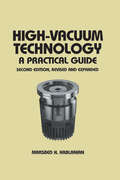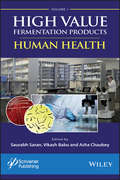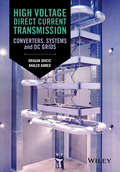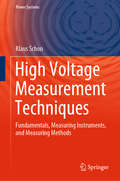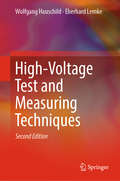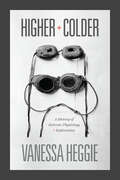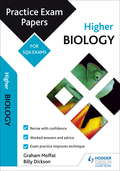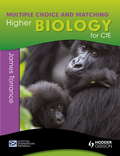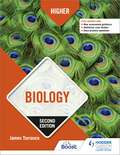- Table View
- List View
High-Throughput Glycomics and Glycoproteomics
by Gordan Lauc Manfred WuhrerThis volume discusses detailed protocols for the analysis of glycosylation at the level of free glycans and glycopeptides. The book covers topics such as the importance of glycans in eukaryotic life (with a focus on mammals and particularly humans); recent technologies that allow the characterization of larger sets of samples; and method repeatability and robustness, as well as higher throughout with respect to sample preparation, measurement and data analysis. The chapters spans a wide range of techniques, including the analysis of fluorescently labeled glycans with HPLC, LC-MS analysis of glycopeptides both for glycosylation profiling and for in-depth tandem mass spectrometric analysis of protein glycosylation, and the analysis of glycans with fluorescent labeling, capillary electrophoresis in conjunction with laser induced fluorescence detection. The chapters also detail specific samples types including brain tissues, N-glycans from in-vitro cell cultures, milk oligosaccharides, invertebrate and protest N-glycans, as well as plant glycans. Written in the highly successful Methods in Molecular Biology series format, chapters include introduction to their respective topics, lists of the necessary materials and reagents, step-by-step, readily reproducible laboratory protocols, and tips on troubleshooting and avoiding known pitfalls. Practical and thorough, High-Throughout Glycomics and Glycoproteomics: Methods and Protocols is an essential reference for researchers planning to enter this rapidly evolving field.
High-Throughput Mass Spectrometry in Drug Discovery
by Chang Liu Hui ZhangHigh-Throughput Mass Spectrometry in Drug Discovery Apply mass spectrometry to every phase of new drug discovery with this cutting-edge guide Mass spectrometry is a technique that identifies and characterizes compounds based on their mass — the fundamental molecular characteristic. It has become an invaluable analytical tool in various disciplines, industries, and research fields. It has become particularly central to new drug discovery and development, which broadly deploys mass spectrometry at every phase. The pharmaceutical industry has become one of the main drivers of technological development in mass spectrometry. High-Throughput Mass Spectrometry in Drug Discovery offers a comprehensive introduction to mass spectrometry and its applications in pharmaceutical discovery. It covers the foundational principles and science of mass spectrometry before moving to specific experimental methods and their applications at various stages of drug discovery. Its thorough treatment and detailed guidance make it an invaluable tool for pharmaceutical research and development. High-Throughput Mass Spectrometry in Drug Discovery readers will also find: Detailed analysis of techniques, including label-free screening, synthetic reaction optimization, and more An authorial team with extensive combined experience in research and industrial applications Technical strategies with the potential to accelerate quantitative bioanalysis in drug discovery High-Throughput Mass Spectrometry in Drug Discovery is essential for analytical, bioanalytical, and medicinal chemists working in the pharmaceutical industry and for any researchers and graduate students interested in drug discovery and development.
High-Throughput Metabolomics: Methods and Protocols (Methods in Molecular Biology #1978)
by Angelo D'AlessandroThis detailed volume focuses on recent technological, computational, and biostatistical advances in the field of high-throughput metabolomics. Chapters encompass methods, platforms, and analytical strategies for steady state measurements and metabolic flux analysis with stable isotope-labeled tracers, in biological matrices of clinical relevance and model organisms. Mass spectrometry-based or orthogonal methods are discussed, along with computational and statistical methods to address data sparsity in high-throughput metabolomics approaches. As a part of the highly successful Methods in Molecular Biology series, chapters include introductions to their respective topics, lists of the necessary materials and reagents, step-by-step, readily reproducible laboratory protocols, and tips on troubleshooting and avoiding known pitfalls. Authoritative and practical, High-Throughput Metabolomics: Methods and Protocols provides tools that can bring about the next generation of clinical biochemistry in a cost-effective, rigorous fashion, exponentially advancing our capacity to investigate nature while hastening the advent of personalized medicine.
High-Throughput Next Generation Sequencing
by Steven C. Ricke Young Min KwonDue to their novel concepts and extraordinary high-throughput sequencing capacity, the "next generation sequencing" methods allow scientists to grasp system-wide landscapes of the complex molecular events taking place in various biological systems, including microorganisms and microbial communities. These methods are now being recognized as essential tools for a more comprehensive and deeper understanding of the mechanisms underlying many biological processes. In High-Throughput Next Generation Sequencing: Methods and Applications, experts in the field explore the most recent advances in the applications of next generation sequencing technologies with an emphasis on microorganisms and their communities; however, the methods described in this book will also offer general applications relevant to the study of any living organisms. Written in the highly successful Methods in Molecular BiologyTM series format, chapters include introductions to their respective topics, lists of the necessary materials and reagents, step-by-step, readily reproducible laboratory protocols, and key tips on troubleshooting and avoiding known pitfalls. Comprehensive and cutting-edge, High-Throughput Next Generation Sequencing: Methods and Applications is an excellent collection of chapters to aid all scientists who wish to apply these innovative research tools to enhance their own pursuits in microbiology and also biology in general.
High-Throughput Phenotyping in Plants
by Jennifer NormanlyGenetic approaches to understanding plant growth and development have always benefitted from screens that are simple, quantitative and rapid. Visual screens and morphometric analysis have yielded a plethora of interesting mutants and traits that have provided insight into complex regulatory pathways, and yet many genes within any given plant genome remain undefined. The premise underlying High Throughput Phenotyping in Plants: Methods and Protocols is that the higher the resolution of the phenotype analysis the more likely that new genes and complex interactions will be revealed. The methods described in this volume can be generally classified as quantitative profiling of cellular components, ranging from ions to small molecule metabolites and nuclear DNA, or image capture that ranges in resolution from chlorophyll fluorescence from leaves and time-lapse images of seedling shoots and roots to individual plants within a population at a field site. Written in the successful Methods in Molecular BiologyTM series format, chapters include introductions to their respective topics, lists of the necessary materials and reagents, step-by-step, readily reproducible protocols, and notes on troubleshooting and avoiding known pitfalls. Authoritative and easily accessible, High Throughput Phenotyping in Plants: Methods and Protocols serves as an invaluable guide to plant researchers and all scientists who wish to better understand plant growth and development.
High-Throughput Plant Phenotyping: Methods and Protocols (Methods in Molecular Biology #2539)
by Argelia Lorence Karina Medina-JimenezThis volume looks at a collection of the latest techniques used to quantify the genome-by-environment-by-management (GxExM) interactions in a variety of model and plant crops. The chapters in this book are organized into five parts. Part One discusses high-throughput plant phenotyping (HTPP) protocols for plants growing under controlled conditions. Part Two present novel algorithms for extracting data from seed images, color analysis from fruits, and other digital readouts from 2D objects. Part Three covers molecular imaging protocols using PET and X-ray approaches, and Part Four presents a collection of HTPP techniques for crops growing under field conditions. The last part focuses on molecular analysis, metabolomics, network analysis, and statistical methods for the quantitative genetic analysis of HTP data. Written in the highly successful Methods in Molecular Biology series format, chapters include introductions to their respective topics, lists of the necessary materials and reagents, step-by-step, readily reproducible laboratory protocols, and tips on troubleshooting and avoiding known pitfalls. Cutting-edge and practical, High-Throughput Plant Phenotyping: Review and Protocols is a valuable resource for both novice and expert researchers looking to learn more about this important field.Chapter 21 is available open access under a Creative Commons Attribution 4.0 International License via link.springer.com.
High Throughput Protein Expression and Purification
by Sharon A. DoyleDespite exciting advances in genome sequencing, isolating a protein from its expression system in its native form still presents a complex challenge. In High Throughput Protein Expression and Purification: Methods and Protocols, leading scientists detail the most successful protocols currently in use, including various high throughput cloning schemes, protein expression analysis, and production protocols. This volume describes the use of E. coli, insect, and mammalian cells, as well as cell-free systems for the production of a wide variety of proteins, including glycoproteins and membrane proteins, in order to best represent strategies that create and exploit common features to enable simplified cloning, stable expression, and purification of proteins. Written in the highly successful Methods in Molecular BiologyTM series format, the chapters present brief introductions to the subject, lists of the necessary materials and reagents, step-by-step, readily reproducible laboratory protocols, and a Notes section for tips on troubleshooting and avoiding known pitfalls. Cutting-edge and comprehensive, High Throughput Protein Expression and Purification: Methods and Protocols is an ideal reference for protein biochemists and all those who wish to apply these easy-to-use protocols to the many applicable fields.
High-Throughput Protein Production and Purification: Methods and Protocols (Methods in Molecular Biology #2025)
by Renaud VincentelliThis book compiles key protocols instrumental to the study of high-throughput protein production and purification which have been refined and simplified over the years and are now ready to be transferred to any laboratory. Beginning with a section covering general procedures for high-throughput protein production, the volume continues with high-throughput protocols adapted to the production of specific protein families, as well as an extensive section on protocols combining high-throughput protein production and their micro-characterization. Written for the highly successful Methods in Molecular Biology series, chapters in this book include introductions to their respective topics, lists of the necessary materials and reagents, step-by-step, readily reproducible laboratory protocols, and tips on troubleshooting and avoiding known pitfalls. Authoritative and practical, High-Throughput Protein Production and Purification: Methods and Protocols serves biochemists ranging from engineers, PhD students and post-doctoral fellows, to the heads of protein expression facilities and researchers, in pursuing this vital area of study.
High-Throughput RNAi Screening
by David O. Azorsa Shilpi AroraHigh-throughput RNAi screening remains one of the most widely used technologies to perform target identification and validation studies in an unbiased manner. These assays are equally important for research and development across academic, biotech, and pharmaceutical industries. The success of these screening efforts is dependent on robust methodologies to perform these screens. In "High-Throughput RNAi Screening: Methods and Protocols, " expert researchers in the field share protocols and methods for performing high-throughput RNAi (HT-RNAi) screens. These include the use of various RNAi platforms and delivery methods in mammalian and non-mammalian systems, whole organism and cell models, and various applications, such as drug sensitizer identification. Finally, the book examines the latest advancements in the fields of assay development, library screening, data analysis, and hit selection. Written in the highly successful "Methods in Molecular Biology "series format, chapters include introductions to their respective topics, lists of the necessary materials and reagents, step-by-step, readily reproducible laboratory protocols, and tips on troubleshooting and avoiding known pitfalls. Cutting-edge and thorough, "High-Throughput RNAi Screening: Methods and Protocols "provides a comprehensive source of protocols and other necessary information to make robust and successful assays possible for all who wish to apply HT-RNAi in their research.
High Throughput Screening
by William P. Janzen Paul BernasconiIn the years since the release of the popular first edition, the field of High Throughput Screening (HTS) has evolved considerably, from a small niche area of study to a major, essential scientific technique. In High Throughput Screening: Methods and Protocols, Second Edition, experts in the field fully update the previous edition to best serve as an introduction to HTS for scientists who are just entering the field, and as a provider of key, significant detail so as to be useful to scientists in established HTS operations. Featuring new screening technologies as well as many well established methods, chapters offer comprehensive treatment of the activities directly related to HTS, such as compound library management, data handling, and robotics. As a volume in the highly successful Methods in Molecular BiologyTM series, this work provides the kind of meticulous description and implementation advice that is crucial for getting optimal results. Authoritative and intrinsically practical, High Throughput Screening: Methods and Protocols, Second Edition promises to share the highest knowledge and enthusiasm with all those who use this versatile technology in their own labs.
High-Throughput Screening Assays in Toxicology
by Hao Zhu Menghang XiaThis book focuses on recently developed High Throughput Screening (HTS) assay protocols, many involved in the ToxCast and/or Tox21 initiatives, and the relevant HTS data analysis techniques. Divided into three sections, in vitro assays, in vivo assays, and computational techniques to analyze HTS data are all examined. Written for the highly successful "Methods in Molecular Biology" series, most chapters include introductions to their respective topics, lists of the necessary materials and reagents, step-by-step, readily reproducible laboratory protocols, and tips on troubleshooting and avoiding known pitfalls. Authoritative and practical, "High Throughput Screening Assays in Toxicology" serves as a valuable reference resource for translating new HTS techniques into standardized chemical toxicity assessment tools in order to advance modern toxicology research to a new era where HTS techniques can partially replace the prevailing animal models.
High-Throughput Screening Assays in Toxicology (Methods in Molecular Biology #2474)
by Hao Zhu Menghang XiaThis second edition volume expands on the previous edition by exploring the latest advancements in high throughput screening (HTS) in toxicity studies by using in vitro, ex vivo, and in vivo models. This volume also covers the application of artificial intelligence (AI) and data science to curate, manage, and use HTS data. Written in the highly successful Methods in Molecular Biology series format, chapters include introductions to their respective topics, lists of the necessary materials and reagents, step-by-step, readily reproducible laboratory protocols, and tips on troubleshooting and avoiding known pitfalls. Cutting-edge and thorough, High Throughput Screening Assays in Modern Toxicology, Second Edition is a valuable resource for scientists pursuing chemical toxicology research. This book will aid scientists and researchers in translating new HTS techniques into standardized chemical toxicology assessment tools that can refine, reduce, and replace animal testing.
High-Throughput Screening Methods in Toxicity Testing
by Pablo SteinbergExplores the benefits and limitations of the latest high-throughput screening methods With its expert coverage of high-throughput in vitro screening methods for toxicity testing, this book makes it possible for researchers to accelerate and streamline the evaluation and risk assessment of chemicals and drugs for toxicity. Moreover, it enables them to comply with the latest standards set forth by the U.S. National Research Council's "Toxicity Testing in the 21st Century: A Vision and Strategy" and the E.U.'s REACH legislation. Readers will discover a variety of state-of-the-science, high-throughput screening methods presented by a group of leading authorities in toxicology and toxicity testing. High-Throughput Screening Methods in Toxicity Testing is divided into five parts: General aspects, including predicting the toxicity potential of chemicals and drugs via high-throughput bioactivity profiling Assessing different cytotoxicity endpoints Assessing DNA damage and carcinogenesis Assessing reproductive toxicity, cardiotoxicity, and haematotoxicity Assessing drug metabolism and receptor-related toxicity Each chapter describes method principles and includes detailed information about data generation, data analysis, and applications in risk assessment. The authors not only enumerate the advantages of each high-throughput method over comparable conventional methods, but also point out the high-throughput method's limitations and potential pitfalls. In addition, the authors describe current research efforts to make high-throughput toxicity screening even more cost effective and streamlined. Throughout the book, readers will find plenty of figures and illustrations to help them understand and perform the latest high-throughput toxicity screening methods. This book is ideal for toxicologists and other researchers who need to implement high-throughput screening methods for toxicity testing in their laboratories as well as for researchers who need to evaluate the data generated by these methods.
High Tide at Gettysburg: The Campaign in Pennsylvania
by Glenn TuckerThe author tries to present how the Gettysburg battle was won and lost, and why the Gettysburg campaign remains such an appealing study to large numbers even after the passing of nearly a century.
High Tide for Horseshoe Crabs
by Lisa Kahn SchnellDual-layered text introduces the life cycle of the horseshoe crab, with a focus on the annual mass-spawning event at Delaware Bay.
High Time-Resolution Astrophysics (Canary Islands Winter School of Astrophysics #27)
by Tariq Shahbaz Jorge Casares Velázquez Teodoro Muñoz DariasHigh time-resolution astrophysics (HTRA) involves measuring and studying astronomical phenomena on timescales of seconds to milliseconds. Although many areas of astronomy, such as X-ray astronomy and pulsar observations, have traditionally required high time-resolution studies, HTRA techniques are now being applied to optical, infrared and gamma-ray wavelength regimes, due to the development of high efficiency detectors and larger telescopes that can gather photons at a higher rate. With lectures from eminent scientists aimed at young researchers and postdoctorate students in observational astronomy and astrophysics, this volume gives a practical overview and introduction to the tools and techniques of HTRA. Just as multi-spectral observations of astrophysical phenomena are already yielding new scientific results, many astronomers are optimistic that exploring the time domain will open up an important new frontier in observational astronomy over the next decade.
High-Vacuum Technology: A Practical Guide, Second Edition
by Marsbed H. HablanianOffering a basic understanding of each important topic in vacuum science and technology, this book concentrates on pumping issues, emphasizes the behavior of vacuum pumps and vacuum systems, and explains the relationships between pumps, instrumentation and high-vacuum system performance. The book delineates the technical and theoretical aspects of the subject without getting in too deep. It leads readers through the subtleties of vacuum technology without using a dissertation on mathematics to get them there. An interesting blend of easy-to-understand technician-level information combined with engineering data and formulae, the book provides a non-analytical introduction to high vacuum technology.
High Value Fermentation Products, Volume 1: Human Health
by Saurabh Saran Vikash Babu Asha ChaubeyGreen technologies are no longer the “future” of science, but the present. With more and more mature industries, such as the process industries, making large strides seemingly every single day, and more consumers demanding products created from green technologies, it is essential for any business in any industry to be familiar with the latest processes and technologies. It is all part of a global effort to “go greener,” and this is nowhere more apparent than in fermentation technology. This book describes relevant aspects of industrial-scale fermentation, an expanding area of activity, which already generates commercial values of over one third of a trillion US dollars annually, and which will most likely radically change the way we produce chemicals in the long-term future. From biofuels and bulk amino acids to monoclonal antibodies and stem cells, they all rely on mass suspension cultivation of cells in stirred bioreactors, which is the most widely used and versatile way to produce. Today, a wide array of cells can be cultivated in this way, and for most of them genetic engineering tools are also available. Examples of products, operating procedures, engineering and design aspects, economic drivers and cost, and regulatory issues are addressed. In addition, there will be a discussion of how we got to where we are today, and of the real world in industrial fermentation. This chapter is exclusively dedicated to large-scale production used in industrial settings.
High Voltage Direct Current Transmission
by Khaled Ahmed Dragan JovcicThis comprehensive reference guides the reader through all HVDC technologies, including LCC (Line Commutated Converter), 2-level VSC and VSC HVDC based on modular multilevel converters (MMC) for an in-depth understanding of converters, system level design, operating principles and modeling. Written in a tutorial style, the book also describes the key principles of design, control, protection and operation of DC transmission grids, which will be substantially different from the practice with AC transmission grids.The first dedicated reference to the latest HVDC technologies and DC grid developments; this is an essential resource for graduate students and researchers as well as engineers and professionals working on the design, modeling and operation of DC grids and HVDC. Key features: * Provides comprehensive coverage of LCC, VSC and (half and full bridge) MMC-based VSC technologies and DC transmission grids. * Presents phasor and dynamic analytical models for each HVDC technology and DC grids. * Includes HVDC protection, studies of DC and AC faults, as well as system-level studies of AC-DC interactions and impact on AC grids for each HVDC technology. * Companion website hosts SIMULINK SimPowerSystems models with examples for all HVDC topologies.
High Voltage Measurement Techniques: Fundamentals, Measuring Instruments, and Measuring Methods (Power Systems)
by Klaus SchonThis book conveys the theoretical and experimental basics of a well-founded measurement technique in the areas of high DC, AC and surge voltages as well as the corresponding high currents. Additional chapters explain the acquisition of partial discharges and the electrical measured variables. Equipment exposed to very high voltages and currents is used for the transmission and distribution of electrical energy. They are therefore tested for reliability before commissioning using standardized and future test and measurement procedures. Therefore, the book also covers procedures for calibrating measurement systems and determining measurement uncertainties, and the current state of measurement technology with electro-optical and magneto-optical sensors is discussed.
High-Voltage Test and Measuring Techniques
by Eberhard Lemke Wolfgang HauschildThe new edition of this book incorporates the recent remarkable changes in electric power generation, transmission and distribution. The consequences of the latest development to High Voltage (HV) test and measuring techniques result in new chapters on Partial Discharge measurements, Measurements of Dielectric Properties, and some new thoughts on the Shannon Theorem and Impuls current measurements. This standard reference of the international high-voltage community combines high voltage engineering with HV testing techniques and HV measuring methods. Based on long-term experience gained by the authors the book reflects the state of the art as well as the future trends in testing and diagnostics of HV equipment. It ensures a reliable generation, transmission and distribution of electrical energy. The book is intended not only for experts but also for students in electrical engineering and high-voltage engineering.
Higher and Colder: A History of Extreme Physiology and Exploration
by Vanessa HeggieDuring the long twentieth century, explorers went in unprecedented numbers to the hottest, coldest, and highest points on the globe. Taking us from the Himalaya to Antarctica and beyond, Higher and Colder presents the first history of extreme physiology, the study of the human body at its physical limits. Each chapter explores a seminal question in the history of science, while also showing how the apparently exotic locations and experiments contributed to broader political and social shifts in twentieth-century scientific thinking. Unlike most books on modern biomedicine, Higher and Colder focuses on fieldwork, expeditions, and exploration, and in doing so provides a welcome alternative to laboratory-dominated accounts of the history of modern life sciences. Though centered on male-dominated practices—science and exploration—it recovers the stories of women’s contributions that were sometimes accidentally, and sometimes deliberately, erased. Engaging and provocative, this book is a history of the scientists and physiologists who face challenges that are physically demanding, frequently dangerous, and sometimes fatal, in the interest of advancing modern science and pushing the boundaries of human ability.
Higher Biology: Practice Papers for SQA Exams
by Graham Moffat Billy DicksonPractise for your SQA exams with three specially-commissioned Hodder Gibson Practice Exam Papers.- Practise with model papers written and checked by experienced markers and examiners- Get extra advice with specially-written study-skills guidance sections- Gain vital extra marks and avoid common mistakes with examiner tips
Higher Biology for CfE: Multiple Choice and Matching
by James Simms Clare Marsh Caroline StevensonThe perfect practice book for multiple choice and matching exercises that make up 20% of the final CfE Higher exam paper. This book offers ideal material for either classroom or homework activities, and allows students to construct a glossary of terms essential to the course, while banks of multiple choice questions enable them to practise extensivelty for the examination.
Higher Biology, Second Edition
by Clare Marsh James Simms Caroline Stevenson James Torrance James FullartonExam Board: SQALevel: HigherSubject: BiologyFirst Teaching: August 2018First Exam: June 2019Ensure that students are prepared for every aspect of Higher Biology with the new edition of this popular textbook from James Torrance and his renowned author team, completely updated for the 2018 changes to the SQA Higher Biology syllabus.- Suggested learning activities throughout help to develop students' knowledge and skills including all new case studies, research topics and investigations- Testing your knowledge questions at the end of each chapter provide opportunities to continually assess Knowledge and Understanding, and are particularly useful for homework tasks- 'What you should know' summaries of key facts and concepts provide an excellent source of material for consolidation and revision prior to the SQA examination.- 'Applying Your Knowledge and Skills' sections at the end of each section have been substantially extended to give students extra practice in exam questions and foster the development of Skills of Scientific Experimentation, Investigation and Enquiry
